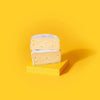Which cheese pairs best with champagne?
By Richard Simpson
Sep 14, 2023

There is nothing quite like celebrating with something sparkling and a fantastic piece of artisan cheese, so here is a guide to the best pairings I’ve come across over the years.
My favourite pairings
Champagne
When it comes to champagne, one of the best pairings I ever had was Laurent Perrier with a 16mth Gruyere. The yeastiness in the champagne worked so well in bringing out some of the more savoury, toasted biscuit/brioche flavours in the cheese, and the cheese seemed to impart a wonderful fruitiness into the wine, balancing its richness.
It was flavour perfection, but also texturally worked so well – the texture of a pairing is often overlooked. It’s important to consider if it’s clean on your palate or oily, and sometimes a bad pairing can get grainy or even cloying.
A richer champagne can really hold its own against a bigger bolder flavour profile, so this is when you can start experimenting with pairings like Bollinger and washed rind cheeses such as Langres, Washington or Maida Vale. These washed rind cheeses cultivate Brevibacterium Linens on their rind (the orange colour) which is a yeast that pairs very nicely (and holds its own) against the yeastiness found in a rich champagne like Bollinger.
English Sparkling Wine
English Sparkling wine is generally lighter and more fruit-forward than traditional champagne, with slightly pared back brioche, biscuit and rich yeast flavours. Nyetimber Brut is probably one of the richer English Sparkling wines, whilst Ridgeview Bloomsbury is more representative of the ‘archetypal’ English sparkler. In terms of flavour profile, I would probably compare Nyetimber to Bollinger or Pol Roger, and Ridgeview to Laurent Perrier. These are my two favourite English Sparkling wines though.
Nyetimber works fantastically well with more complex cheeses like Spenwood (aged Sheep’s milk cheese) and Tunworth (a Camembert style cheese). If you follow the ‘what grows together goes together’ mantra, then pairing Tunworth with Hattingley estate wine, just down the road from us, is well worth trying.
Ridgeview Bloomsbury is best paired with a fresh goat’s milk cheese or lactic cow’s milk cheese. A recent pairing experience threw up some wonderful pairings in Ingot, a goat’s milk cheese from Cumbria, and also Cote Hill Snowdrop, a very young fresh cow’s milk cheese that miraculously has a subtle yeasty, meaty complexity at just a few weeks old.
Best Rules of Thumb
Not all of us necessarily have Laurent Perrier, Bollinger, Ridgeview or Nyetimber at our fingertips round the clock (sadly). So, here are some more general rules of thumb to help you navigate pairing cheese with champagne/sparkling wine more generally.
The easiest way to approach this is looking at the blend. If you have a higher Chardonnay proportion in the blend (Blanc de Blanc being the most extreme example, being 100% Chardonnay) then you want to look for a slightly lighter, fresher, creamier profile of cheese. Goat’s milk cheese works well here, as do younger hard cheeses. We are looking for more of the lactic flavours (ie taste associated with milk) such as butter, cream, acidity.
If we have a wine that has a higher Pinot Noir blend (Blanc de Noirs for example using only black grape varieties) then you can look for cheese that has more complexity and body, for example mature hard cheeses and cheeses that exhibit more richness away from lactic flavours (eg nutty, meaty, earthy, mushroom).
What doesn’t work?
First of all, blue cheese is very tricky to pair with champagne/sparkling wine. The only real approach here is to go for a Demi Sec wine, which has increased sweetness that can counter-balance the saltiness of blue cheese. This is certainly worth a try. But other than that, there are far better cheese pairings out there.
There is also a very famous tradition of Langres and Champagne, given the two are produced in the same region (the grow together go together theme again). Langres is a washed-rind cheese deliberately made with a dent or indentation on the top which is designed to receive a splash of champagne.
I would highly recommend NOT doing this. I mentioned earlier that texture is a hugely important part of pairing. There is a wonderful freshness and cleanness you get when you wash away a piece of creamy cheese with a small sip of sparkling wine. The acidity but also the bubbles work so nicely to cleanse the palate, leaving just a lovely aftertaste (in the case of a good pairing).
However, when you pour champagne onto Langres, it produces this fizzing, fermented, cloying mush of cheese which on your palate is very unpleasant, and also tends to leave grains or pellets of rind in your mouth afterwards.
I would suggest the best way to taste any wine and cheese is a sip of the wine first, then a bite of cheese, and then another sip of wine. Never at the same time!
Hopefully you find these tips useful, and as with all these things, never be afraid to experiment – we often find the best pairings in the most unexpected places.
Enjoy!


